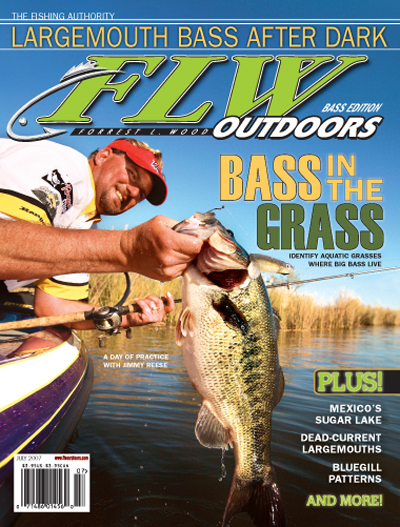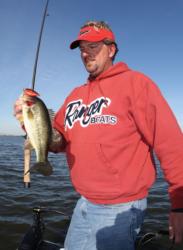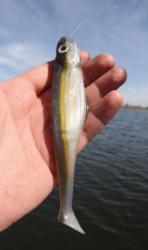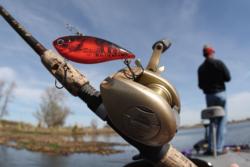Day of Practice: Jimmy Reese
Wal-Mart FLW Series National Guard Western Division, California Delta

When you’re hot, you’re hot. Two tournament wins in the Stren Series Western Division in 2006, along with fifth- and 14th-place finishes led to Jimmy Reese handedly winning the division points title.
These stats don’t even reflect titles and earnings collected from other tournament circuits in 2006. Also, as of press time, Reese has 2007 Stren Series finishes of sixth, 16th and 26th. He also finished in 38th place at the inaugural Wal-Mart FLW Series National Guard Western Division event at Lake Havasu.
It’s plain to see, Jimmy Reese of Witter Springs, Calif., is one of the hottest sticks in the West.
I joined Reese for practice at the season’s second FLW Series Western Division event on the California Delta. Reese lives a couple hours north of the Delta, but shouldn’t be considered a local.
“Last year, I only fished the Delta twice,” Reese said, “both for tournaments. I used to fish here about four times per year until I really got familiar with it. But now I usually just fish here for two tournaments a year. Every time I’m here, I fish places I’ve never fished, just to learn more about it.”
Reese won the Stren Series California Delta tournament last season, but he had never fished the Delta this early in the year.
He launched at 6:45 a.m. near Russo’s Marina on Bethel Island on the event’s first day of practice – March 10. The tide, a factor that can complicate matters on the Delta, was coming in.
“I look at tide charts, but it will really take me about two days to figure out the tides,” Reese explained.
As he idled down one of the many canals, Reese described his initial thoughts on what it may take to win. “I think I’ll need 21 pounds a day to win,” he said. “But I did that last year in a WON BASS event and came in 31st. So it could take as much as 25 pounds per day to win.”
Reese’s first stop was half a mile from the ramp. He pulled out a red 1/2-ounce WaterStriker Pro Trap – a lipless crankbait.
At around 7:15, while fishing around tules in a levee break, Reese caught a small striped bass. A minute later, another boat idled in too close for Reese’s comfort, so he decided to leave. As with many pros, he tries to keep his practice strategies (including baits) secret. The Pro Trap has produced well for him on the Delta in the past.
At 7:30, Reese pulled up on an entrance to one of the dozens of “ponds” within the Delta waterway and started fishing a ledge that dropped off into the canal. The ledge was along a narrow channel that dropped from 2 feet to 10 feet. His bait of choice was a Texas-rigged green pumpkin Zoom Brush Hog.
 “I really need to be here when the water is going out,” he said, “but I’m just trying to figure out what is going on. Fishing is easier for me here during outgoing tides. It would be a lot easier if this was a lake with no tides.”
“I really need to be here when the water is going out,” he said, “but I’m just trying to figure out what is going on. Fishing is easier for me here during outgoing tides. It would be a lot easier if this was a lake with no tides.”
After a few minutes with no hits, Reese moved into the shallow pond and pulled out several hard swimbaits. He tied on several 7-inchers of the same brand and threw them to observe the action. Although they were all the same model, he selected the third swimbait and threw the other two in the livewell so they could soak all day and become waterlogged. That way they wouldn’t float so high in the water. Then he cranked up the trolling motor and started working the swimbait around the banks and tules.
“I’m just searching,” Reese said. “Sparse tules are great places to throw swimbaits – or any bait for that matter.”
At 8:30, he idled a couple hundred yards to another pond and started fishing a Senko, but switched to a Mission Fish swimbait and his Trap. He fished along a levee. The boat was sitting in 7 feet of stained water.
At 8:45, Reese landed a 2-pounder on the Trap. The fish was sitting in a grass bed 6 feet deep.
“I just realized the weedline is a little farther off the bank,” he said.
Over the next 10 minutes, he caught another 2-pounder, missed a fish and caught a short fish on a white Mission Fish swimbait.
 The flurry of bites continued. At 9:20, Reese caught another 2-pounder on the Trap; a 2-pounder on a Brush Hog a few minutes after that; another 2-pounder on the Trap at 9:40; and a short fish and another 2-pounder on the Trap a few minutes after that.
The flurry of bites continued. At 9:20, Reese caught another 2-pounder on the Trap; a 2-pounder on a Brush Hog a few minutes after that; another 2-pounder on the Trap at 9:40; and a short fish and another 2-pounder on the Trap a few minutes after that.
At this time, the tide had started to recede. Most of the bites came in less than 6 feet of water near breaks in levees where current was creating eddies.
The action never slowed down as he eased up to several large levee breaks where water was pouring out of the pond he was fishing. Between 10 and 10:30, Reese caught two short fish, four 2-pounders, a 3-pounder and shook off a fish because another boat was close. All the fish came on the Trap.
The weather that day was very pleasant – 70 degrees, clear, with a light wind. But the Bay Area had not received many warm days prior to the practice period, and the water temperature was in the mid-50s. Reports indicated the bite had been on fire a few weeks earlier, but had slowed. Reese wasn’t impressed with what he found.
“I’m not sure what to think right now,” he said. “I thought I would have caught a few more 3s and some 4s. I still haven’t found the place I will start the tournament. I’m not frustrated yet, because I still have a lot of looking to do, and this is still the first morning of practice.”
He stopped a little while to eat lunch and idled across the pond to graph the bottom.
 “The water is starting to get right, with the tide going out,” Reese explained. “It’s getting clearer. When the water is clear, I’ll spend a lot of time just looking to see what the fish are doing – cruising, bedding, suspending. If you put the trolling motor on high for a couple hours and just look, you can learn a ton. Here at the Delta, the tide has to be right for the water to be clear.”
“The water is starting to get right, with the tide going out,” Reese explained. “It’s getting clearer. When the water is clear, I’ll spend a lot of time just looking to see what the fish are doing – cruising, bedding, suspending. If you put the trolling motor on high for a couple hours and just look, you can learn a ton. Here at the Delta, the tide has to be right for the water to be clear.”
Starting at 11:30, Reese moved often, sampling a variety of areas. He fished very shallow ponds; large flats in 4 to 5 feet of water; and rocky and grassy points created by joining canals. Along with the baits he used during the morning, he experimented with a ChatterBait, drop-shot, frog and buzzbait. But the afternoon only produced a few small fish.
Shortly after noon, Reese idled into a shallow pond that had water temps in the high 50s. He picked up a buzzbait and threw it for an hour.
“I’m frustrated now,” he sighed. “They won’t hit the buzzbait, and I don’t know why. I usually have a lot of success with a buzzbait in these conditions.”
Reese continued to move from spot to spot. He talked with numerous anglers throughout the afternoon, and they all had the same disappointed tone in their voice. One pro exclaimed: “This place isn’t supposed to be this tough.”
“Tomorrow I’ll go to different areas and try something else,” Reese said. “I’ve still got three days of practice. The fish are biting somewhere; they have to be. The water is in the mid- to high 50s and the fish are in prespawn mode. There are more 3- to 7-pound fish in this place than any other lake in the country. Somebody will get them.”
 Tale of the tape
Tale of the tape
Jimmy Reese’s practice period was like a roller coaster – up and down. On his second day of practice, he took a swimbait to an area he didn’t fish the previous day and experienced one of his best days ever on the water.
“I hit an area with the right weather and the right tide and had an amazing day,” Reese said. “I caught a fish close to 10 pounds and several other big fish and could have weighed about 32 pounds. They were eatin’ it!
“But the conditions were not right for me during the tournament, and I couldn’t catch those big fish. The right tide for my areas was later in the afternoon, about when weigh-in started or even later, so that didn’t help me any.
“I tried to throw the swimbait in the mornings on days one and two, but I already knew it wouldn’t work for me,” he said.
Reese caught limits weighing 15-11 and 13-8 on days one and two – mediocre for that event. However, he rebounded on day three and jumped up the field with a stronger limit of 17-2. Reese finished with a three-day weight of 48-5 and earned a check for $2,000.
“I was able to catch a larger limit on day three because I was patient. I went farther west, where the tide starts going out earlier, and just stayed off my fish until the tide was right, a little after 2 p.m.,” he said. “That didn’t leave me much time before weigh-in, but I was able to catch a little better limit.”
Michael Rooke of Lake Havasu City, Ariz., won the event with a four-day total of 20 fish weighing 93 pounds, 5 ounces.